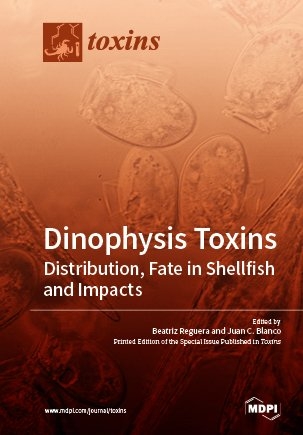
Dinophysis Toxins: Distribution, Fate in Shellfish and Impacts
Seiten
2019
MDPI (Verlag)
978-3-03921-363-4 (ISBN)
MDPI (Verlag)
978-3-03921-363-4 (ISBN)
- Keine Verlagsinformationen verfügbar
- Artikel merken
Several species of Dinophysis produce one or two groups of lipophilic toxins: okadaic acid (OA) and its derivatives; or the dinophysistoxins (DTXs) (also known as diarrhetic shellfish poisons or DSP toxins) and pectenotoxins (PTXs). DSP toxins are potent inhibitors of protein phosphatases, causing gastrointestinal intoxication in consumers of contaminated seafood. Forty years after the identification of Dinophysis as the causative agent of DSP in Japan, contamination of filter feeding shellfish exposed to Dinophysis blooms is recognized as a problem worldwide. DSP events affect public health and cause considerable losses to the shellfish industry. Costly monitoring programs are implemented in regions with relevant shellfish production to prevent these socioeconomic impacts. Harvest closures are enforced whenever toxin levels exceed regulatory limits (RLs). Dinophysis species are kleptoplastidic dinoflagellates; they feed on ciliates (Mesodinium genus) that have previously acquired plastids from cryptophycean (genera Teleaulax, Plagioselmis, and Geminigera) nanoflagellates. The interactions of Dinophysis with different prey regulate their growth and toxin production. When Dinophysis cells are ingested by shellfish, their toxins are partially biotransformed and bioaccumulated, rendering the shellfish unsuitable for human consumption. DSP toxins may also affect shellfish metabolism. This book covers diverse aspects of the abovementioned topics—from the laboratory culture of Dinophysis and the kinetics of uptake, transformation, and depuration of DSP toxins in shellfish to Dinophysis population dynamics, the monitoring and regulation of DSP toxins, and their impact on the shellfish industry in some of the aquaculture regions that are traditionally most affected, namely, northeastern Japan, western Europe, southern Chile, and New Zealand.
| Erscheinungsdatum | 05.10.2019 |
|---|---|
| Verlagsort | Basel |
| Sprache | englisch |
| Maße | 170 x 244 mm |
| Themenwelt | Medizin / Pharmazie ► Pharmazie |
| Studium ► 2. Studienabschnitt (Klinik) ► Pharmakologie / Toxikologie | |
| Schlagworte | accumulation • Aquaculture • Argopecten irradians • Argopecten purpuratus • bacterial community • Biotransformation • bivalves • bivalve shellfish • Blooms • Brazil • climatic anomaly • compartmentalization • cryptophytes • D. acuminata-complex • D. caudata • Deep sequencing • Defense • Depuration • Diarrheic Shellfish Poisoning • diarrhetic shellfish poisoning • diarrhetic shellfish toxins • diarrhetic shellfish toxins (DST) • Digestion • dinophysis • Dinophysis acuminata • Dinophysis acuta • dinophysistoxin • dinophysistoxins • Dinophysis toxins • DSP • DSP toxins • DST accumulation • DST esterification • DTX-2 • El Niño Southern Oscillation • HAB monitoring • Harmful algal bloom • Harmful Algal Blooms • high throughput sequencing • Human health • immunity • Japanese scallop • Kinetics • LC/MS/MS • lysate • marine biotoxins • marine toxins • mass culture conditions • Mesodinium • Mesodinium cf. rubrum • Mesodinium rubrum • Metabolism • mixotrophic cultures • Mussel • Mytilus galloprovincialis • N/A • New Zealand • niche partitioning • OA • okadaic acid • OMI analysis • Organic Matter • pectenotoxin • pectenotoxins • pectenotoxins (PTXs) • physical–biological interactions • pipis (Plebidonax deltoides) • Port Underwood • predator-prey preferences • Protoceratium reticulatum • PTXs • qPCR • Reloncaví Fjord • resistance • RNA-Seq • Scotland • seasonality • shellfish toxicity • Southern Annual Mode • Statistical Analysis • surf clam • Suspended particulate matter (SPM) • Sydney rock oyster (Saccostrea glomerata) • Time-Series • toxin accumulation • toxins • toxin vectors • transcriptomic response • trophic transfer • wild harvest • WitOMI analysis |
| ISBN-10 | 3-03921-363-6 / 3039213636 |
| ISBN-13 | 978-3-03921-363-4 / 9783039213634 |
| Zustand | Neuware |
| Haben Sie eine Frage zum Produkt? |
Mehr entdecken
aus dem Bereich
aus dem Bereich
Buch | Hardcover (2024)
Thomas Karow (Verlag)
CHF 79,95
Buch | Hardcover (2022)
Urban & Fischer in Elsevier (Verlag)
CHF 138,60


